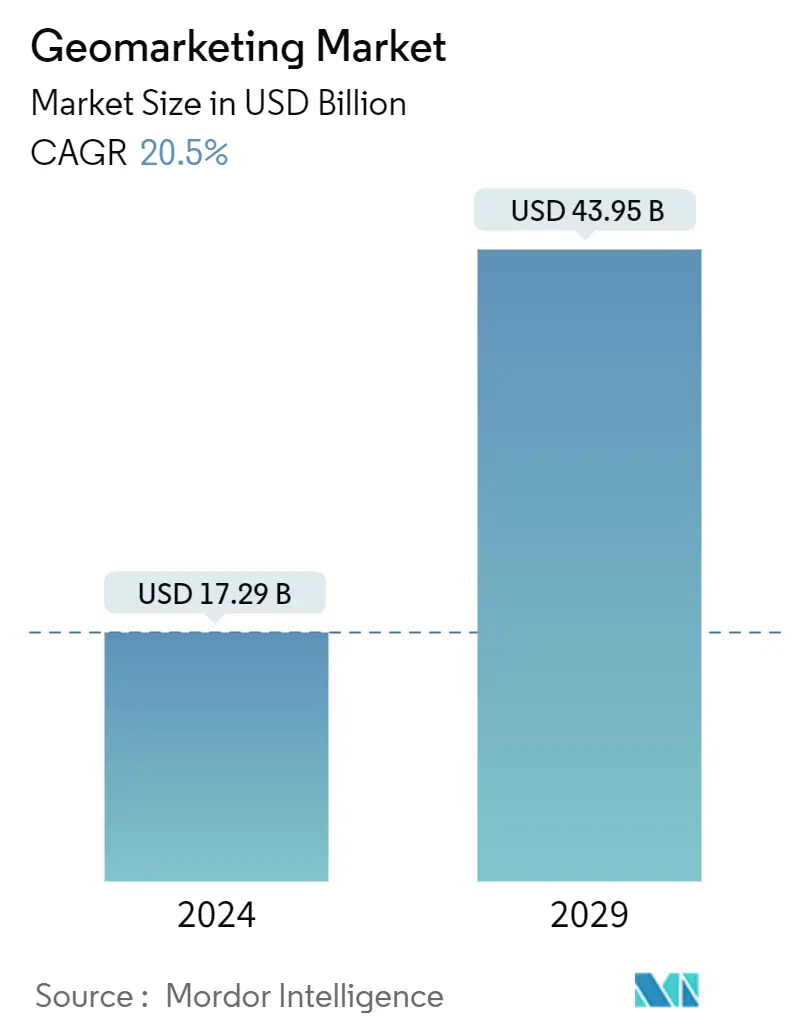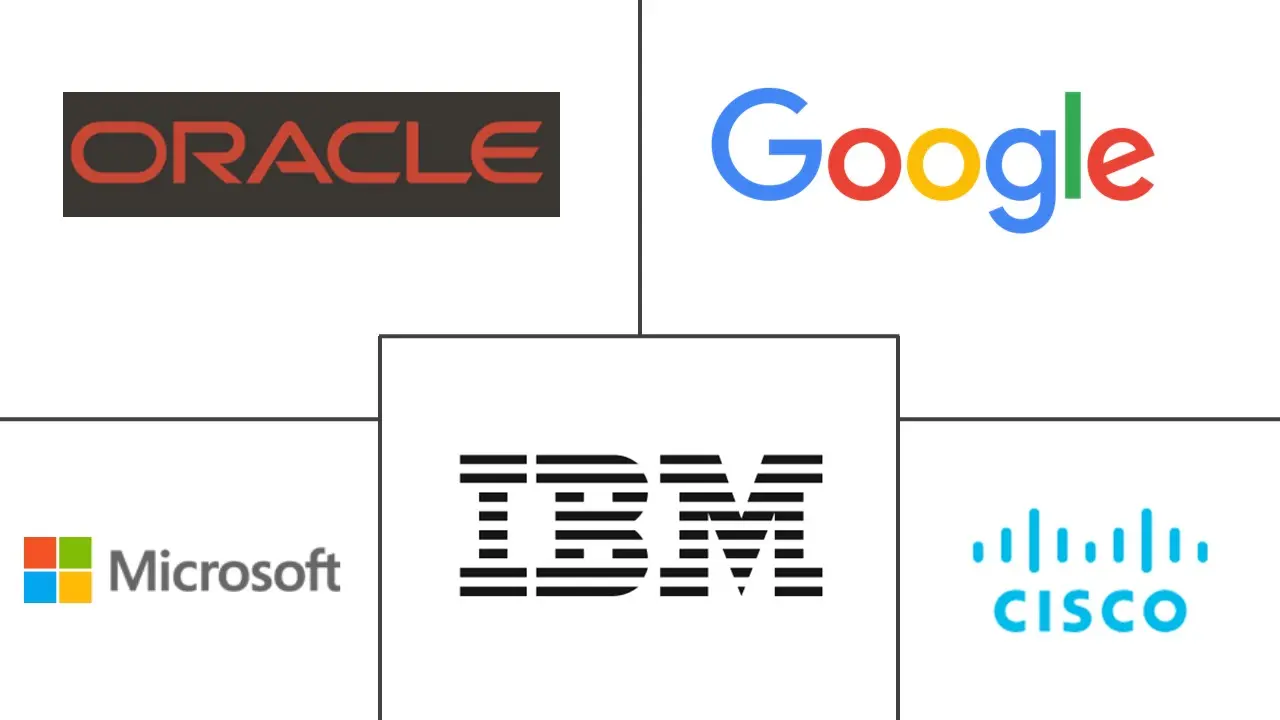Market Size of Geomarketing Industry

| Study Period | 2019-2029 |
| Market Size (2024) | USD 17.29 Billion |
| Market Size (2029) | USD 43.95 Billion |
| CAGR (2024 - 2029) | 20.50 % |
| Fastest Growing Market | Asia Pacific |
| Largest Market | North America |
| Market Concentration | Low |
Major Players
*Disclaimer: Major Players sorted in no particular order |
Geo Marketing Market Analysis
The Geomarketing Market size is estimated at USD 17.29 billion in 2024, and is expected to reach USD 43.95 billion by 2029, growing at a CAGR of 20.5% during the forecast period (2024-2029).
Increasing adoption of digital mapping by many businesses, technological advancement in location-based analytics, and the increasing need to analyze the considerable business data to draw spatial reference insights to supply the right product to the right consumer at the right time can surge a company's revenue are some of the primary factors boosting geomarketing market.
- Increasing establishments of multinational companies in different geographical locations with various cultural, demographic, food, and linguistics preference have forced companies to opt for geomarketing software that would provide a series of data and information that can be employed to identify and convert potential customers to actual customers through marketing strategy. Geomarketing provides a way to meet the challenges faced by communication service providers.
- The factors driving the geomarketing market are the increased demand for advanced digital marketing technologies, the adoption of big data platforms, and ongoing innovation in business intelligence solutions. Adopting advanced technologies (IoT, advanced analytics, edge computing, and blockchain) has increased device connectivity. With the rise in digital transformations, organizations have started moving toward digital marketing tools by incorporating the location intelligence of the target customers rather than traditional tools, as these offer more affordability and customer engagement.
- For instance, Dänisches Bettenlager, a Denmark-based home décor retailer, is currently utilizing the geomarketing solution of WIGeoGIS for planning and optimizing brochure advertising. It also aims to reduce the daily traveling time of sales managers through a new and optimized sales structure.
- Location-based intelligence services are a solution that utilizes the device's geographical location to provide information to the user. The technology has gained considerable significance and is becoming an integral part of organizations due to the numerous benefits offered by location-based Intelligence solutions, including store locators, proximity-based marketing, real-time information, weather reports, mobile workforce management, roadside assistance, traffic updates, and fraud prevention. The rise in GPS-enabled precision applications, such as farming, logistics, and automotive, has created a high demand for location-based solutions to enhance business revenue.
- Many countries' lack of uniform regulatory standards has raised customer data privacy concerns. Further, security concerns as applications and networks are under persistent security threats such as malicious code and service denial can lead to data loss and leakage, hampering the market's growth in the future.
- The outbreak of COVID-19 led to the large-scale transfer of sales from physical stores to digital stores, leading to large-scale data usage by consumers of various sectors. Organizations were keeping up with their technology enhancement and investment to engage customers in times of panic buying and stay-at-home guidelines at the global level. Organizations also reduced productivity declines, with businesses providing all the essential infrastructure and technology support to their customers by adopting advertising and marketing strategies through digital media. Such factors have led organizations to adopt more geomarketing solutions, leading to market growth. With the rapid adoption of digital geomarketing technology, advanced marketing analytics tools drive market growth in the post-pandemic scenario.
Geo Marketing Industry Segmentation
Geo-marketing is a tool that works on geographic or location-based information and is used by companies to build their marketing strategies and campaigns based on customers' location data. It employs digital mapping to organize and display data, enabling marketers to analyze data by region or a particular physical location. It analyzes customer data from online transactions, mobile devices, and other sources stored in company databases and applies to digital maps, for example, a zip-code map or a street map, to locate the customer. It is also used by various businesses to understand the customer experience.
The geo-marketing market is segmented by component (software and services), deployment (cloud and on-premise), location (indoor and outdoor), end-user verticals (BFSI, IT and telecommunications, retail and e-commerce, media and entertainment, and travel and hospitality), geography (North America, Europe, Asia Pacific, Latin America, and Middle East and Africa). The market sizes and forecasts are provided in terms of value in USD for all the above segments.
| By Components | |
| Software | |
| Services |
| By Deployment | |
| Cloud | |
| On-Premise |
| By Location | |
| Indoor | |
| Outdoor |
| By End-User Industry | |
| BFSI | |
| IT and Telecommunications | |
| Retail and E-commerce | |
| Media and Entertainment | |
| Travel and Hospitality | |
| Other End-user Industries |
| By Geography | |
| North America | |
| Europe | |
| Asia Pacific | |
| Latin America | |
| Middle East and Africa |
Geomarketing Market Size Summary
The geomarketing market is poised for significant growth, driven by the increasing adoption of digital mapping and advancements in location-based analytics. Businesses are increasingly leveraging these technologies to analyze vast amounts of data, drawing spatial insights to optimize product delivery to consumers. The rise of multinational companies with diverse cultural and demographic footprints has further propelled the demand for geomarketing software, enabling businesses to identify and convert potential customers through targeted marketing strategies. The integration of advanced technologies such as IoT, edge computing, and blockchain has enhanced device connectivity, making digital marketing tools more appealing due to their affordability and ability to engage customers effectively. The shift from traditional to digital marketing tools, particularly in the wake of the COVID-19 pandemic, has accelerated the adoption of geomarketing solutions, as organizations seek to maintain customer engagement and drive revenue growth.
North America is expected to lead the geomarketing market, supported by substantial IT investments and the presence of major technology vendors. The region's high adoption of IoT technologies and 5G-enabled devices is anticipated to fuel market expansion, allowing businesses to deliver personalized marketing strategies in real-time. The market is characterized by a high degree of fragmentation, with key players like Microsoft, IBM, Oracle, and Google actively enhancing their service offerings through partnerships and innovations. These companies are leveraging location-based services to provide tailored marketing solutions across various sectors, including telecommunications, transportation, and retail. The ongoing collaboration between financial institutions and IT providers to deliver location-based products and services further underscores the market's growth potential. As businesses continue to harness the power of geomarketing, the market is expected to witness robust expansion, driven by technological advancements and evolving consumer expectations.
Geomarketing Market Size - Table of Contents
-
1. MARKET INSIGHTS
-
1.1 Market Overview
-
1.2 Industry Attractiveness Porter's Five Forces Analysis
-
1.2.1 Threat of New Entrants
-
1.2.2 Bargaining Power of Buyers/Consumers
-
1.2.3 Bargaining Power of Suppliers
-
1.2.4 Threat of Substitute Products
-
1.2.5 Intensity of Competitive Rivalry
-
-
1.3 Assessment of COVID-19 Impact on the Market
-
-
2. MARKET SEGMENTATION
-
2.1 By Components
-
2.1.1 Software
-
2.1.2 Services
-
-
2.2 By Deployment
-
2.2.1 Cloud
-
2.2.2 On-Premise
-
-
2.3 By Location
-
2.3.1 Indoor
-
2.3.2 Outdoor
-
-
2.4 By End-User Industry
-
2.4.1 BFSI
-
2.4.2 IT and Telecommunications
-
2.4.3 Retail and E-commerce
-
2.4.4 Media and Entertainment
-
2.4.5 Travel and Hospitality
-
2.4.6 Other End-user Industries
-
-
2.5 By Geography
-
2.5.1 North America
-
2.5.2 Europe
-
2.5.3 Asia Pacific
-
2.5.4 Latin America
-
2.5.5 Middle East and Africa
-
-
Geomarketing Market Size FAQs
How big is the Geomarketing Market?
The Geomarketing Market size is expected to reach USD 17.29 billion in 2024 and grow at a CAGR of 20.5% to reach USD 43.95 billion by 2029.
What is the current Geomarketing Market size?
In 2024, the Geomarketing Market size is expected to reach USD 17.29 billion.

